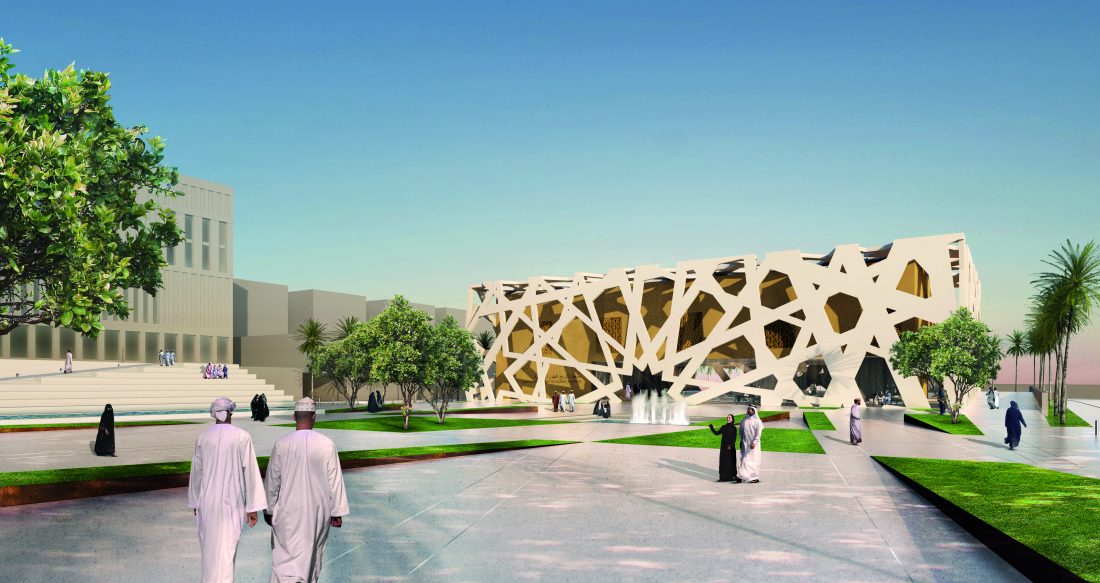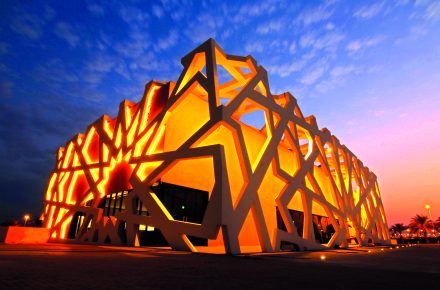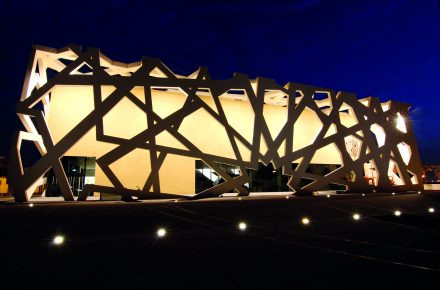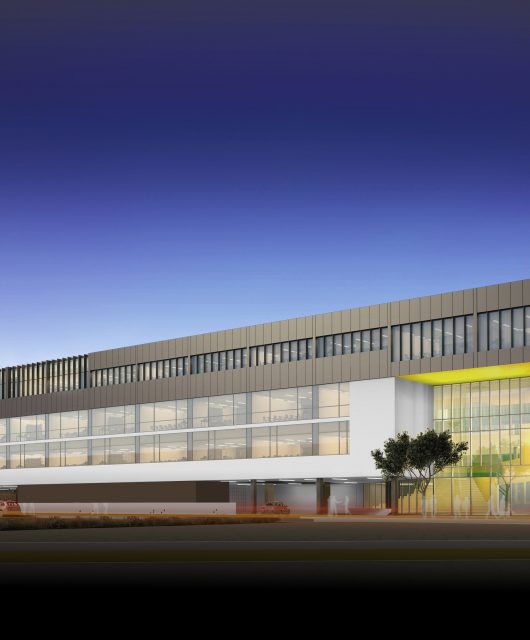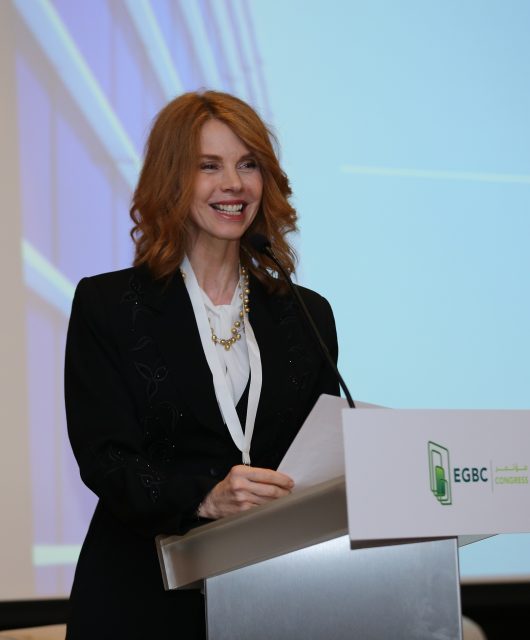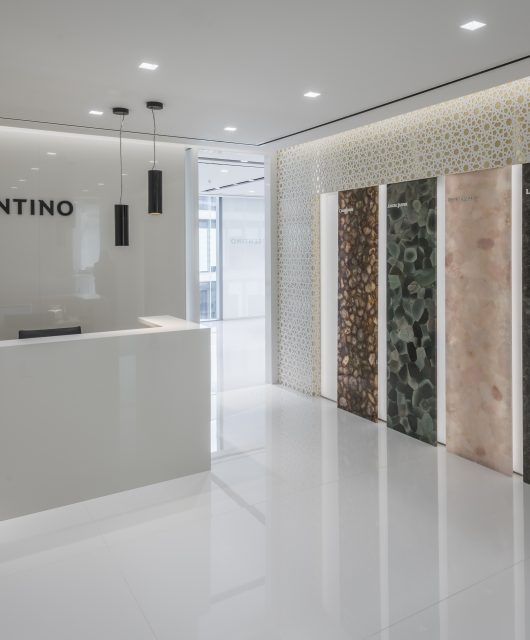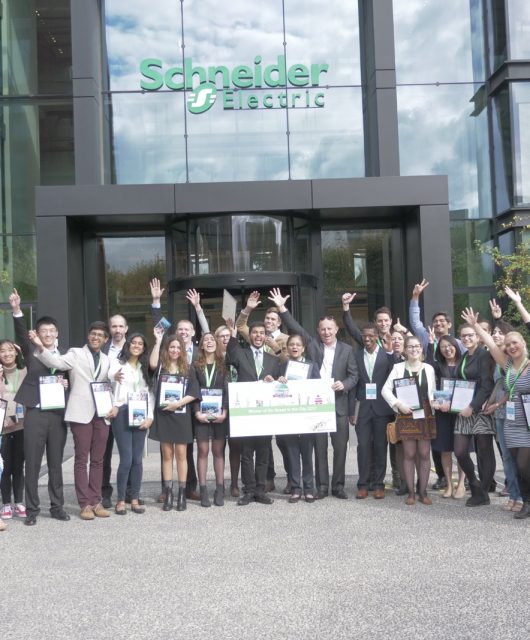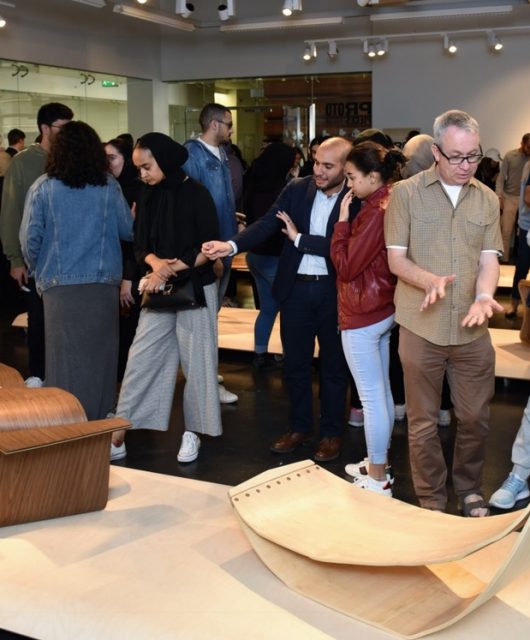Modern Mashrabiya
Ancient geometric patterns adorn a new exhibition space that pays tribute to the golden age of Islamic science. Muhammad Sultan Al Salmy, managing partner and lead architect of Muscat-based firm Hoehler+alSalmy, talks us through the adventurous concept…
The structure was still being built when its designers learned they had won an award. Clad in a concrete latticework shell that mimics the ancient art of mashrabiya, the Conference and Exhibition Hall at GUtech Oman, a striking addition to Muscat’s main technical university and was designed by Hoehler+alSalmy, a partnership between German architect Ernst Hoehler and his Omani counterpart, Muhammad Sultan Al Salmy.
Praised in the World Architecture Forum’s 10+5+X WA Awards 24th Cycle, the ambitious scheme blends European precision and Middle Eastern flair, acting as as a mediator between the Islamic world’s ‘golden age’ of scientific innovation with today’s university studies at Muscat’s German University of Technology Oman (GUtech). The building aims to create a link between art and science with nature and geometry while symbolising infinity and divinity, and will house a permanent display that pays tribute to the ingenuity of the early Islamic world.
“There’s evidence of a lot of scientific work that was carried out during this period but the instruments were lost,” Al Salmy says.
“There are books that prove that such devices would have worked, but no one can find them any more. There are just bits and pieces of them.” Although some call the building a museum, Al Salmy hesitates to use the term.
“A museum would always hold old, original artefacts – that’s what you would call a museum,” he STUNNING: The Conference and Exhibition Hall at GUtech, Oman, houses replicas of groundbreaking inventions from across the ancient Islamic world adds. “For me, it’s an exhibition because everything within it was made specifically for this building. Yes, they’re from books, they’re ‘old’, but they’re replicas.” It is divided into two sections; the external standalone mashrabiya is a concrete latticework shell that houses the gallery area of the internal building, while the internal structure is elevated on a platform.
An inclined internal surface is incorporated in line with the sun and wind direction as a thermal control element, while a star-shaped entrance leads the way to a high entrance hall.
The permanent display of replica instruments is housed on the first floor, accessed by an unusual staircase that is said to represent an architectural journey. While the exhibition’s scope encompasses geography, mathematics, physics, astronomy and maritime achievements, feats from which Al Salmy and Hoehler drew no end of inspiration, they felt that, architecturally, something was missing.
“Usually when you create an exhibition space or a museum it’s a black box – it’s what you have inside that counts – and often it’s an old building that has been renovated.”
Al Salmy and Hoehler wanted to create a “smart building” that would also represent the region’s history. The building’s core is modelled on a traditional Omani house, made of the same mud as the country’s old forts. This is surrounded by a wall of glass, over which is laid concrete latticework shell in a type of ancient geometric pattern called mashrabiya. Such designs appear all over the Islamic world, but Al Salmy wanted something very specific. “We knew that it’s used all over here in the Middle East and even farther afield – it’s everywhere. But we wanted to trace its origins, to find out which patterns were most famous and how it evolved.
“We didn’t want to pick a pattern and copy and paste it over the windows – we wanted to do something really modern, and to use technology to make it function in a different way.”
The pattern they chose was copied from the complex that houses Africa’s largest mosque. Qarawiyyin, in Fes, Morocco, dates back to AD857 and was founded by Fatima Fihiyya, the daughter of a wealthy Tunisian merchant – the shapes appear on its wall tiles in bright shades of blue, green and yellow.
At GUtech, these forms take on another dimension. The shell’s thickness varies according to its location, providing exposed parts of the building with extra protection against harsh summer rays.

Sunlight is harnessed in several ways to create interesting shadows. Once a year, on 21 July, a solar eclipse has a striking effect on the building, penetrating the mashrabiya’s apertures and illuminating a second layer of latticework inside. “We wanted the building to add something to the science exhibition,” says Al Salmy.
“The geometric shape on the outside will be cast in shadows onto the inner windows, and within that window there is a smaller mashrabiya – and only on that specific day you will have the perfect shadow.”
The sundial was invented by the Greeks, but its design was refined by the Ottomans and they were used extensively in the Islamic world to help calculate prayer times. The Conference and Exhibition Hall has a hole in the roof though which sunlight penetrates; a sundial will be installed below it, possibly by pouring molten metal into a mould set within the wooden flooring. The exhibition space’s lower level, the free-standing box protected and wrapped by the façade, will include a children’s play area, a temporary exhibition area and a heritage research library for both locals’ and tourists’ use, as well as a coffee shop overlooking a dhow placed in the shallow water feature resembling a marina. Built by maritime scientists specially for the exhibition, the boat is based upon a drawing that is thought to be the oldest sketch of a dhow in existence and depicts a vessel that set sail from Oman to India.
“We created a little mooring,” Al Salmy adds. “If you’re sitting in the coffee shop on the ground floor you can look up at it – it’s as if it’s floating.”
“We’ve already had calls from galleries in Germany that want to exhibit modern art there, so it’s already getting a lot of attention. But the client doesn’t want to do anything yet. They say they can they can only do something once the first-floor exhibition is ready, because that’s really what made all of this start.”
A COMPLEX SCHEME
The construction took place in just 18 months. The scheme’s project manager, Muatasim Al Kindi, says: “It was challenging from the beginning because the lattice structure is isolated from the main building so it was like building two structures at once.” Several items had to be custom-made, including several huge panels of glass, chosen for its ability to block both noise and UV rays.
“If you go during this time of year, the A/C is not even turned on, but you feel comfortable,” he says. “To us, the major challenges were regarding getting hold of the materials, which were abroad. For example, the wooden flooring was originally from Austria, and it had to be there with the windows so we could proceed with the project.”
Like Al Salmy, he’s proud of the results. “Everyone who passes by says ‘Wow’. It’s right next to GUtech, which is one of the projects we’re very proud of, and it is something that you never get bored of looking at. Because of the mashrabiya, it looks different from each angle. And if you see it during the day it’s a different from when you look at it at night.” Liner LED lights were used on the exterior façade, and the extravagant lighting is impactful. Al Kindi adds: “With most buildings, people only care about the front façade. Here it looks good on every side. Normally on the roof, you would just see the A/C units – on this you will see the mashrabiya. That is what’s nice about it – that it’s attractive from every angle, even if you see it from the plane.”
With the building finished, Hoehler+alSalmy has embarked on the interiors, as well as imaginative landscaping the team has dubbed ‘the carpet’.
Al Salmy says: “We call it the carpet because when we elevated the box, the plaza forms a connection with the park behind the exhibition centre and continues when you go inside and it continues to the plaza at the front of the exhibition hall, connecting it to the main building adjacent to it..”
“In Oman we don’t have plazas, we don’t have places where people would gather like you’d have in Europe. Within the master plan we developed, the client loved the idea of the plaza, so right now we’re designing the building adjacent to the museum – it’s going to be the library.”
Back in Germany, Ernst Hoehler is apparently also thrilled. “He made a big contribution to this,” Al Salmy says. “The first idea for it came when we were sitting together in Germany having dinner and sketching what it could be like. He had the idea of elevating the box and from there it all exploded. “Ernst wanted to stay closely involved in the exhibition and it’s like this project is his baby, more or less – he is so proud of it, even though it’s a small building, because it’s so different from the university.
“When we last met the client, we asked him: ‘Do you really like the building?’ and he said: ‘It is my jewel’. It was really a nice answer. “As for us, we just can’t wait to open it to the public. I have a lot of clients who say: ‘Please give us a sneak preview’ and we’re not allowed to do it, because the client wants to make the opening a real event for everyone. We’re really proud of this building.”

